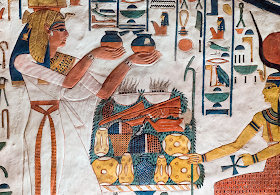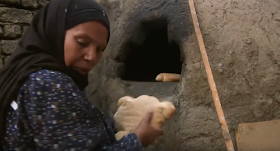These are wall paintings depicting offerings to gods
The tomb of Menna (1388–1351 BC), TT69, Theban Necropolis
The Tomb of Nakht (c. 1401 – 1391 BC), TT52, Theban Necropolis
This is the so called "Shamsi Bread" the sun-raised bread ("shamsi" meaning "sun" in Arabic) still made in Upper Egypt today.
The flour is first sifted in a large sieve, the coarser grains left to dust the hands and homemade clay bread platters. After washing the hands, a prayer asking God's blessing is usually said to ensure a proper rising, as bread is considered a gift from God (Sun god???).
The flour is mixed with water, a bit of salt and is then worked into a smooth dough.
Loaves dry on the outside and develop a thin crust while rising on the inside.
Just before the baking, the loaves are scored for decoration using a large needle or pin and the crust is pulled apart.
Muslims make three crescent-like cuts
The oven is lit from the back
And the inside is wiped with a wet cloth, causing the inside of the oven to fill with steam
The bread is then placed inside the hot oven
And the oven is closed.
The bread is baked for 20 minutes.
The bread changes shape depending on how it is scored.
Muslim breads with three crescent scores turn into triangle shaped loaves.
Christian breads with four crescent scores turn into cross shaped loaves
Bread is thick and soft, not at all like the usual Egyptian flatbread.
Herodotus (484 – 425 BC) mentions this sourdough bread of Luxor, very different from the more familiar pocket bread of Cairo. So we know that this bread was made in the 5th c. BC.
During the excavations of the Settlement and Cemetery at Giza dated to the reigns of Khafre and Menkaure (mid-4th Dynasty, c. 2472–2442 BC), archaeologists have found bread baking oven.
Inside of the oven, the archaeologists found five partial or nearly complete ceramic vessels. Most of these were shallow baking plates (platters) or trays.
These platters or trays are crudely made, poorly fired, and fragile. Platters are associated with the baking process. In ethnographic studies these platters (called apr.t) have parallels with modern Egyptian vessels used for making ‘eish shams, or sun bread. Peet and Woolley describe a modern baking method by villagers living near Amarna in which they place the dough on unfired platters or plates, and both platter and bread are then baked together in the oven (Peet and Woolley 1923: 64). Also, unfired trays and trays fired at low temperature or partially fired have been discovered in the Elephantine bakery from the First Intermediate Period (2181–2055 BC), T. Rzeuska, personal communication). These trays often break when the bread is taken off.
From "Settlement and Cemetery at Giza: Papers from the 2010 AERA-ARCE Field School" edited by Freya Sadarangani and Alexandra Witsell
So it seems that sun breads were already made in Egypt at the end of the 3rd millennium BC.
As for decorations, particularly the central circular one and the dots.
Inside of the oven, the archaeologists found five partial or nearly complete ceramic vessels. Most of these were shallow baking plates (platters) or trays.
These platters or trays are crudely made, poorly fired, and fragile. Platters are associated with the baking process. In ethnographic studies these platters (called apr.t) have parallels with modern Egyptian vessels used for making ‘eish shams, or sun bread. Peet and Woolley describe a modern baking method by villagers living near Amarna in which they place the dough on unfired platters or plates, and both platter and bread are then baked together in the oven (Peet and Woolley 1923: 64). Also, unfired trays and trays fired at low temperature or partially fired have been discovered in the Elephantine bakery from the First Intermediate Period (2181–2055 BC), T. Rzeuska, personal communication). These trays often break when the bread is taken off.
From "Settlement and Cemetery at Giza: Papers from the 2010 AERA-ARCE Field School" edited by Freya Sadarangani and Alexandra Witsell
So it seems that sun breads were already made in Egypt at the end of the 3rd millennium BC.
As for decorations, particularly the central circular one and the dots.
A lot of breads deposited in the tombs were found found lying on offering tables when the tombs were opened for the first time. This is low rectangular table for bread. Deir el-Medina / Tomb of Kha, New Kingdom, XVIII dynasty, Amenhotep II - Amenhotep III (1428-1351 BCE).
Most of them have the central indentation just like the breads in the tomb wall paintings.
The triangular bread in the middle of the first row still has visible prick mark decorations
In the end:
This is the Egyptian ideogram of "niwt" meaning a "city", "village" or a general location occupied by people.
The sign already existed before the unification of the two parts of Egypt and is one of the oldest known hieroglyphs, dating from the pre-dynastic period.
The accepted explanation is that "this hieroglyph is derived from the graphic renderings of walled enclosure, which were depicted on flattened stones (palettes) found near Abydos in Upper Egypt and dating from the end of the fourth millennium BC..."
But is it possible that this hieroglyph is derived from the sun bread, meaning "any place where bread is made or eaten"? Or was the sun bread decoration derived from the "niwt" symbol?




































Do you think there might be a connection between Vinca prosopomorphic amphora lids and Egyptian canopic jars?
ReplyDeleteDefinitely...
DeleteWhen my mum baked bread, and when the bread had to be left to 'rise', my mother told me that her mother (my grandmother) would say that the bread has to go to its 'mother'. Do you know about this saying? I have a Macedonian background.
ReplyDeleteThis is really interesting. Thank you. I don't know what the meaning of this would be...
DeleteAhh, but of course...
DeleteLook at this:
https://oldeuropeanculture.blogspot.com/2020/02/mistress-of-house.html
http://oldeuropeanculture.blogspot.com/2015/12/baba-earthen-bread-oven.html
Also, the natural yeast "sourdough" starter was once called "mother of bread"...
Delete